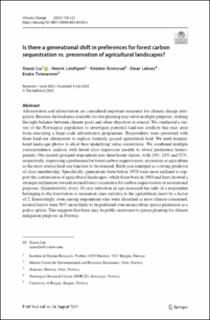| dc.contributor.author | Liu, Xiaozi | |
| dc.contributor.author | Lindhjem, Henrik | |
| dc.contributor.author | Grimsrud, Kristine | |
| dc.contributor.author | Leknes, Einar | |
| dc.contributor.author | Tvinnereim, Endre Meyer | |
| dc.date.accessioned | 2023-09-29T12:02:09Z | |
| dc.date.available | 2023-09-29T12:02:09Z | |
| dc.date.created | 2023-09-14T10:13:36Z | |
| dc.date.issued | 2023 | |
| dc.identifier.issn | 0165-0009 | |
| dc.identifier.uri | https://hdl.handle.net/11250/3093124 | |
| dc.description.abstract | Afforestation and reforestation are considered important measures for climate change mitigation. Because the land area available for tree planting may serve multiple purposes, striking the right balance between climate goals and other objectives is crucial. We conducted a survey of the Norwegian population to investigate potential land-use conflicts that may arise from executing a large-scale afforestation programme. Respondents were presented with three land-use alternatives to replace formerly grazed agricultural land. We used manipulated landscape photos to elicit their underlying value orientations. We combined multiple correspondence analysis with latent class regression models to reveal preference heterogeneity. Our models grouped respondents into three latent classes, with 24%, 24% and 52%, respectively, expressing a preference for forest carbon sequestration, recreation or agriculture as the most crucial land-use function to be retained. Birth year emerged as a strong predictor of class membership. Specifically, generations born before 1970 were more inclined to support the continuation of agricultural landscapes, while those born in 1980 and later showed a stronger inclination towards natural forest succession for carbon sequestration or recreational purposes. Quantitatively, every 10-year reduction in age increased the odds of a respondent belonging to the forestation or recreation class (relative to the agricultural class) by a factor of 2. Interestingly, even among respondents who were classified as most climate concerned, natural forests were 50% more likely to be preferred over monoculture spruce plantation as a policy option. This suggests that there may be public resistance to spruce planting for climate mitigation purposes in Norway. | en_US |
| dc.language.iso | eng | en_US |
| dc.publisher | Springer | en_US |
| dc.rights | Navngivelse 4.0 Internasjonal | * |
| dc.rights.uri | http://creativecommons.org/licenses/by/4.0/deed.no | * |
| dc.title | Is there a generational shift in preferences for forest carbon sequestration vs. preservation of agricultural landscapes? | en_US |
| dc.type | Journal article | en_US |
| dc.type | Peer reviewed | en_US |
| dc.description.version | publishedVersion | en_US |
| dc.rights.holder | Copyright 2023 The Author(s) | en_US |
| dc.source.articlenumber | 123 | en_US |
| cristin.ispublished | true | |
| cristin.fulltext | original | |
| cristin.qualitycode | 1 | |
| dc.identifier.doi | 10.1007/s10584-023-03588-z | |
| dc.identifier.cristin | 2174981 | |
| dc.source.journal | Climatic Change | en_US |
| dc.relation.project | Norges forskningsråd: 280393 | en_US |
| dc.relation.project | Norges forskningsråd: 288037 | en_US |
| dc.relation.project | Norges forskningsråd: 319917 | en_US |
| dc.relation.project | Norges forskningsråd: 315990 | en_US |
| dc.identifier.citation | Climatic Change. 2023, 176 (9), 123. | en_US |
| dc.source.volume | 176 | en_US |
| dc.source.issue | 9 | en_US |

